Research News
-
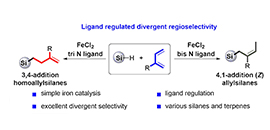 08 31, 2020Researchers Propose Strategy for Catalytic Regiodivergent Hydrosilylation of Isoprene
08 31, 2020Researchers Propose Strategy for Catalytic Regiodivergent Hydrosilylation of Isoprene
Due to the possible formation of a set of regioisomers in chemical reactions, controlling the regioselectivity has been a fundamental issue in organic synthesis.
Organosilanes are widely used in silicon rubbers, paper releasing coatings, and pressure-sensitive adhesives. Catalytic hydrosilylation of alkenes represents a simple strategy for the synthesis of organosilanes.
So far, the catalytic hydrosilylation of alkenes focused more on simple alkenes while less on hydrosilylation of naturally abundant terpenes because it's hard to differentiate four electronically unbiased alkenylcarbons on isoprene.
Regiodivergent hydrosilylation of isoprene (Image by KUAI Chang-Sheng)
Recently, a research team led by Prof. CHEN Qing'an from the Dalian Institute of Chemical Physics (DICP) of the Chinese Academy of Sciences (CAS) proposed a novel "ligand regulation" strategy to realize iron-catalyzed regiodivergent isoprene hydrosilylation.
Their findings were published in Angew. Chem. Int. Ed.
The key to success relies on the coordination number of the ligand to the iron center. The utilization of tri-N ligand enabled the formation of 3,4-adducts homoallylsilanes, whereas varying to bis-N ligand switched the selectivity to 4,1-adducts allysilanes.
This study contributes to the art of regioselectivity control in alkene hydrofunctionalization. It was supported by National Natural Science Foundation of China. (Text by KUAI Chang-Sheng) -
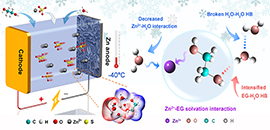 08 27, 2020Scientists Develop Low-temperature Resisting Aqueous Zinc-based BatteriesScientists from DICP developed a frigostable, cost-effective, safe and eco-friendly hybrid electrolyte for aqueous for aqueous zinc-based batteries.
08 27, 2020Scientists Develop Low-temperature Resisting Aqueous Zinc-based BatteriesScientists from DICP developed a frigostable, cost-effective, safe and eco-friendly hybrid electrolyte for aqueous for aqueous zinc-based batteries.
Aqueous zinc-based batteries (ZBBs) are widely used for portable and grid-scale applications due to their high safety, low cost and high energy density.
However, the inhomogeneous zinc deposition on anode during charging and the zinc dendrite formation decrease the cycling stability of ZBBs. Moreover, the traditional aqueous electrolytes are not capable of working at low temperature due to the suddenly dropped ionic conductivities, limiting the applicable temperature range of aqueous ZBBs.
Recently a research group led by Prof. LI Xianfeng from the Dalian Institute of Chemical Physics (DICP) of the Chinese Academy of Sciences (CAS) developed a low-temperature resisting, cost-effective, safe and eco-friendly hybrid electrolyte for aqueous ZBBs.
This work was published in Energy & Environmental Science.
Schematic illustration of the ZBBs with hybrid electrolytes at low temperatures and possible mechanism of how Zn2+-EG solvation interaction impacts the chemistry of the hybrid electrolyte (Image by CHANG Nana)
The developed electrolyte, consisting of water (H2O), ethylene glycol (EG) and zinc sulfate (ZnSO4), exhibited high zinc-ion conductivity at low temperature.
"We demonstrated the unique solvation interaction of Zn2+ with EG through experiments together with theoretical calculation," said Prof. LI.
This interaction could not only enhance the hydrogen bonding between EG and H2O, providing the hybrid electrolyte with lower freezing point, but also weaken the solvation interaction of Zn2+ with H2O, achieving highly reversible Zn/Zn2+ chemistry and uniform zinc deposition.
Both the Zn-ion hybrid supercapacitors (ZHSCs) and Zn-ion batteries (ZIBs) with the hybrid electrolytes showed high energy densities, high power densities and long-cycle life at -20 °C. This series of hybrid electrolytes with tunable EG-to-H2O ratios provided good balance between performance and cost, which enabled promising application in various regions.
This work offers enlightenment for designing electrolytes for low-temperature energy storage devices. It was supported by the Natural Science Foundation of China and CAS Engineering Laboratory for Electrochemical Energy Storage. (Text by CHANG Nana) -
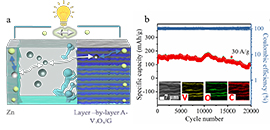 08 24, 2020Scientists Develop Layer-by-layer Stacked 2D Heterostructures for High-performance Zinc Ion BatteriesScientists from DICP developed high capacity and ultra-long life rechargeable aqueous zinc ion batteries (ZIBs) with stable layer-by-layer amorphous 2D heterostructures combining high conductive graphene and amorphous V2O5 (A-V2O5/G-ZIBs) by 2D template ion-adsorption approach.
08 24, 2020Scientists Develop Layer-by-layer Stacked 2D Heterostructures for High-performance Zinc Ion BatteriesScientists from DICP developed high capacity and ultra-long life rechargeable aqueous zinc ion batteries (ZIBs) with stable layer-by-layer amorphous 2D heterostructures combining high conductive graphene and amorphous V2O5 (A-V2O5/G-ZIBs) by 2D template ion-adsorption approach.
The aqueous zinc-ion batteries are competitive, easy-processing and safe electrochemical energy storage devices. However it suffers from the poor cyclability and unattainable capacity caused by dissolution of vanadium, inferior conductivity, volume expansion and structural instability of typical high-capacity vanadium based cathode materials.
Recently, a research group led by Prof. WU Zhongshuai from the Dalian Institute of Chemical Physics of the Chinese Academy of Sciences developed high-capacity and ultra-long-life rechargeable aqueous zinc ion batteries (ZIBs) with stable layer-by-layer amorphous 2D heterostructures combining high conductive graphene and amorphous V2O5 (A-V2O5/G-ZIBs) by 2D template ion-adsorption approach.
This work was published in Energy Storage Materials on June 23.
(a) Schematic of the discharging and charging states of A-V2O5/G-ZIBs with Zn as anode and A-V2O5/G heterostrcuture as cathode. (b) Long cyclability of A-V2O5/G-ZIBs at 30 A/g and cross-section EDX mapping of V, O and C elements on 2D A-V2O5/G heterostructures (inset). (c) V 2p3/2 and Zn 2p3/2 XPS spectra of 2D A-V2O5/G cathode at pristine, fully discharged and charged states. (Image by WANG Xiao)
"The ZIBs we developed presented high capacity of 447 mAh/g at 0.3 A/g, extraordinary rate capability of 202 mAh/g at 30 A/g, and ultra-long lifespan up to 20,000 cycles at 30 A/g, Owing to the unique features with strong synergistic effect," said Prof. WU.
Moreover, the new-concept planar interdigital zinc ion micro-batteries, constructed by mask-assisted filtration strategy, displayed large volumetric capacity of 63 mAh/cm3 at 0.2 mA/cm2, high volumetric energy density of 49 mWh/cm3, robust flexibility, and impressive modular integration in series and in parallel for boosting the capacity and voltage output. They were demonstrative of great potential as microscale power sources.
This work provides various opportunities to construct layer-by-layer stacked 2D heterostructures with fast ion-electron conductivity for ZIBs and other batteries.
This work was supported by National Natural Science Foundation of China, National Key R&D Program of China. (Text by WANG Xiao) -
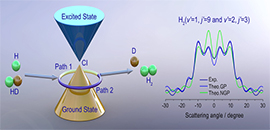 08 21, 2020Scientists Observe Geometric Phase Effect in Chemical Reaction below Conical IntersectionScientists from DICP and their collaboration observed the GP effect in the H+HD→ H2+D reaction below the conical intersection (CI).
08 21, 2020Scientists Observe Geometric Phase Effect in Chemical Reaction below Conical IntersectionScientists from DICP and their collaboration observed the GP effect in the H+HD→ H2+D reaction below the conical intersection (CI).
The geometric phase (GP) effect is an important quantum dynamical phenomenon. It represents the phase acquired when a quantum state is adiabatically transported around a closed circuit in the parameter space while remaining in the same Hilbert space.
In a molecule, the presence of conical intersection leads to the appearance of the GP effect in the adiabatic ground state. In the previous studies, the influence of the GP effect on molecular spectrum has been well understood. However, how the GP acts on the chemical reaction remains unclear.
Observation of the geometric phase effect in the H+HD→H2+D reaction below the conical intersection (Image by HUANG Yin)
Recently, Prof. SUN Zhigang and Prof. YANG Xueming from the Dalian Institute of Chemical Physics (DICP) of the Chinese Academy of Sciences (CAS), in collaboration with Prof. WANG Xingan from University of Science and Technology of China, observed the GP effect in the H+HD→ H2+D reaction below the conical intersection (CI).
This study was published in Nature Communications on July 20.
"We focused on the case of the reaction energy lower than the CI. In this case, the GP effect became much weaker and was more difficult to observe." said Prof. SUN.
The scientists observed the GP effect in H+HD→ H2+D reaction at 2.28 eV, which was well below the CI, by further improving the high-resolution time-sliced velocity map imaging-CMB technique and developing quantum dynamical method based on hyperspherical coordinates. The GP effect was clearly identified by the observation of distinct oscillations in the differential cross section around the forward direction.
Quasi-classical trajectory analysis revealed that GP effect was caused by the interference between usual direct abstraction reaction pathway and roaming-like abstraction reaction pathway.
This study proved soundly the existence of the GP effect in a chemical reaction after adaptation of the Born-Oppenheimer approximation, and the influence of GP on chemical reaction was manifested by oscillations of differential cross section.
The work was highly praised by reviewers. One reviewer commented: "I regard this study as an outstanding advance in this classic (but not classical!) reaction system. It is the stuff that should go into future textbooks. As someone who tried but failed to observe the same phenomenon, I am in awe of what has been accomplished." The second reviewer also commented: "This experiment has been the dream of at least one generation of physical chemists and these results are simply beautiful… I believe this work will be included in physical chemistry textbooks, since it demonstrates a fundamental quantum feature on chemical reaction dynamics."
The study was supported by the National Key R&D Program of China, the National Natural Science Foundation of China, and the Strategic Priority Research Program of Chinese Academy of Sciences. (Text by HUANG Yin) -
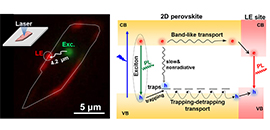 08 21, 2020Scientists Reveal Trap-Enabled Long-Distance Carrier Transport in Perovskite Quantum WellsScientists from DICP reported trap mediated long-distance carrier transport beyond the limit of exciton in PEA2(MA)n-1PbnI3n+1 (n=2-4) single-crystals. And the carrier diffusion distance could be as long as 2 to 5 μm, which was on the same order of 3D perovskites and other traditional semiconductor QWs.
08 21, 2020Scientists Reveal Trap-Enabled Long-Distance Carrier Transport in Perovskite Quantum WellsScientists from DICP reported trap mediated long-distance carrier transport beyond the limit of exciton in PEA2(MA)n-1PbnI3n+1 (n=2-4) single-crystals. And the carrier diffusion distance could be as long as 2 to 5 μm, which was on the same order of 3D perovskites and other traditional semiconductor QWs.
Layered two-dimensional (2D) hybrid perovskites are naturally-formed multiple quantum well (QW) materials. They are promising for applications in quantum and optoelectronic devices due to features like flexible structures, large exciton binding energy, readily tunable bandgap (thickness of QW) and prominently improved moisture resistance.
In previous reports, it is believed that the carrier diffusion distance is limited by a short exciton lifetime and small mobility, which may not be able to compete with three-dimensional (3D) perovskites and other traditional semiconductor QWs.
Recently, a research team led by Prof. JIN Shengye and Prof. TIAN Wenming from the Dalian Institute of Chemical Physics (DICP) of the Chinese Academy of Sciences (CAS) reported trap mediated long-distance carrier transport beyond the limit of exciton in PEA2(MA)n-1PbnI3n+1 (n=2-4) single-crystals. The carrier diffusion distance could be as long as 2 to 5 μm, which was on the same order of 3D perovskites and other traditional semiconductor QWs.
This work was published in J. Am. Chem. Soc. on August 5.
Long-distance carrier transport in an exfoliated 2D perovskite crystal (Image by ZHAO Chunyi and TIAN Wenming)
The scientists observed the long-distance carrier transport beyond the limit of exciton in pure-phase layered 2D perovskites. By using time-resolved photoluminescence (PL) imaging microscope, they found that carriers in 2D perovskites travel in a nonluminescent (dark) state, making the transport process “unseen” by only collecting exciton emission.
The presence of low-energy (LE) emission sites specifically locating at exfoliated crystals edges provided a unique spectroscopic handle for the scientists to observe such "dark" carrier transport.
"We proposed the carrier transport mechanism that a portion of excitons underwent a fast dissociation process, generating a charge-separated state with hole at a trap state and electron at conduction band (CB)," said Prof. TIAN.
The recombination of electron at CB with the trapped hole was slow (on hundreds of ns time scale) and nonradiative, thus enabling a long-range transport with little PL in the pathway. Once they reached a LE site, the electron and hole could be collected and turned into a luminescent state with LE PL.
This unique property makes organic-inorganic hybrid 2D perovskites an ideal candidate for high-efficiency quantum and optoelectronic devices whose performance relies on a long-range carrier or energy flow.
This work was supported by the NFSC, the MOST, the Strategic Priority Research Program of Chinese Academy of Sciences and Youth Innovation Promotion Association CAS. (Text by ZHAO Chunyi and TIAN Wenming) -
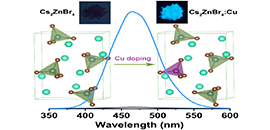 08 19, 2020Method to Develop Blue-emitting Zero-dimensional All-inorganic Metal HalidesScientists from DICP studiied the dynamic mechanism of all-inorganic zero-dimensional (0D) metal halides, and achieved high PLQY in pure-blue spectral region by doping copper into cesium zinc halides.
08 19, 2020Method to Develop Blue-emitting Zero-dimensional All-inorganic Metal HalidesScientists from DICP studiied the dynamic mechanism of all-inorganic zero-dimensional (0D) metal halides, and achieved high PLQY in pure-blue spectral region by doping copper into cesium zinc halides.
All-inorganic zero-dimensional (0D) metal halides are widely applied in the fields of display and solid-state lighting due to their excellent photoluminescence (PL) properties and high stability.
At present, 0D metal halides have achieved high photoluminescence quantum yields (PLQYs) in green, yellow and red light region. By contrast, the development of high-efficiency blue-emitting 0D metal halides remains challenging.
Recently, a research group led by Prof. HAN Keli from the Dalian Institute of Chemical Physics (DICP) of the Chinese Academy of Sciences studied the dynamic mechanism of all-inorganic 0D metal halides, and obtained high PLQY in pure-blue spectral region by doping copper into cesium zinc halides.
This work was published in Angew. Chem. Int. Ed. on August 12.
The doping of Cu+ into 0D Cs2ZnBr4 caused an evident excitonic absorption peak, and successfully transformed the weakly luminescent Cs2ZnBr4 to a bright blue-emitting material with high PLQY. (Image by CHENG Pengfei)
The scientists synthesized copper doped 0D cesium zinc halide single crystals. After the incorporation of Cu+ into Cs2ZnBr4, an obvious exciton absorption peak appeared, while the PL peak position did not change.
The PLQY increased from 3.6% to 65.3%. Meanwhile, the PL lifetime was significantly longer, indicating that Cu+ doping could effectively inhibit the non-radiative recombination process in Cs2ZnBr4.
Detailed spectral analysis showed that the blue emission in Cs2ZnBr4:Cu originated from triplet self-trapped excitons, and exhibited the characteristics of dual emission at low temperatures. And Cs2ZnBr4:Cu also exhibited good humidity and thermal stability.
In addition, scientists obtained an efficient sky-blue emission (PLQY ~73.1%) of Rb2ZnCl4:Cu by substitution a-site cation and halogen.
This work provides an effective strategy for the development of environmentally friendly, low-cost and high-efficiency blue-emitting 0D all-inorganic metal halides.
The study was supported by the National Natural Science Foundation of China and the National Key Research and Development Program of China. (Text by CHENG Pengfei)